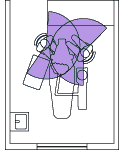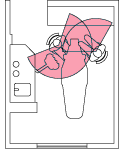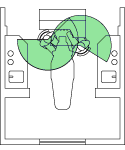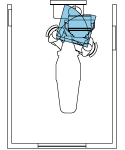One of the most valuable and lasting improvements that any dentist can contribute to a successful practice is an investment in great office design. Whether remodeling an existing office or creating a brand new facility from scratch, there are several essential elements to focus on in designing an office that will help create a more productive, comfortable, quiet and user-friendly practice. There are many distinct styles of practice. Clearly, dental office design is an individual matter based on one’s needs and budget. Nevertheless, the following key issues are common to any office: esthetics; the empowerment of key personnel; controlling noise; and creating rapid access to key equipment and materials.
Setting up of the operating bay
Ergonomics is critical to the day-to-day practice of dentistry. Dentistry is a complex process involving many elements (including diagnosis, communication, management, etc.) but, when you come down to it, it’s fundamentally a manufacturing process. When viewed in this light it just makes sense that the best manufacturer must have the best equipment in the best work environment. And that doesn’t mean the most expensive. Delivery system layouts and critical range of motion will help you maximize productivity while reducing operator and staff fatigue and discomfort.
Delivery system layouts
Determining your delivery system layout is one of the first steps to improving the overall health and performance of your clinical practice. A general practitioner may only use handpieces 10% of the time, but handpiece placement shapes the remaining room layout.
Too often practioners focus on handpiece placement and compromise more significant aspects of overall practice success. There are four distinct handpiece placement choices, which are – over the patient, side delivery, rear delivery, and over the head, and these are the pros and cons of each choices:
Over the patient (O.T.P.)
PROS
- Smaller room size
- Inexpensive to equip
- Space available for specialty equipment
- Handpieces at fingertips from 12 o’clock position
CONS
- Disinfection / cleaning of treatment space is very labor intensive
- Doctor and assistant must work with less than 180 degree range of motion
- Room must be heavily stocked for efficiency
- Doctor and assistant cannot individually reach all supplies
- Expensive to equip
Side delivery
PROS
- Smaller room size
- Patients less threatened by handpieces in their visual/personal space than with O.T.P. deliveryÂ
CONS
- Disinfection / cleaning of treatment space is labor intensive
- Doctor and assistant must work with less than 180 degree range of motion
- Assistant trapped in room during procedure
- Room must be heavily stocked for efficiency
- Right and left convertibility poor
- Doctor and assistant cannot reach all supplies
- Specialty equipment cannot be easily deployed
Rear delivery
PROS
- Assistant free to circulate
- Space available for specialty equipment
- Patients not threatened by the sight of handpieces
- Good for dentistry from 7 o’clock position, O.K. from 11 o’clock position
- Good right and left convertibility is possibleÂ
CONS
- Disinfection / cleaning of treatment space is very labor intensive
- Doctor and assistant must work with less than 180 degree range of motion
- Room must be heavily stocked for efficiency
- Doctor and assistant cannot individually reach all supplies
- Expensive to equip
Over the head
PROS
- Smaller room size
- Inexpensive to equip
- Space available for specialty equipment
- Handpieces at fingertips from the 12 o’clock position
- Assistant free to circulate
- Great for dentistry from 7 o’clock and 12 o’clock positions
- Doctor and assistant range of motion less than 90 degrees
- Patients not threatened by the sight of handpieces
- Right/left convertibility is excellent
CONS
- Handpieces at doctor’s non-dominant hand
Setting up of store room area
The first determination you need to make when considering how you will setup your sterilization area is whether you want a room centric or an office centric. First let’s describe the difference between these two practice types.
Room centric consists of having rooms that are fully stocked at all times with several weeks worth of the supplies you will use to do your dentistry. These rooms typically have large amounts of cabinetry both at the head and side walls to help store all of these items.
This method of stocking your treatment rooms can be quite effective in smaller offices (2-3 treatment rooms) for a few reasons: Inventory control across 3 rooms or less is fairly easy, especially if each room is stocked identically, space is less likely to exist in a 3 op office for a truly centralized sterilization and resupply area, likewise the need to mobilize technology is not as great.
Office centric on the other hand is the type of practice that the vast majority of supplies will be kept in a central sterilization & resupply area. Only small amounts of supplies are kept in the treatment rooms. (A typical ratio of supplies in sterilization to supplies in treatment is 5-1) If you are stocked for 1 weeks’ worth of typical dentistry within your rooms, your treatment area will have 5-6 weeks. This allows for you to order supplies once a month and still maintain your capacity during peak demand flow.
Another key principle is that your rooms are not stocked with everything you need. Your rooms will ideally be stocked with what you need to do 90% of your most common procedures.
The materials for less frequent procedures will be kept either in A) separate tubs in central sterilization for specific procedures (Implants, Dentures, etc.) or B) mobilized to readily deployable rapid carts so that they may be delivered chair side at a moment’s notice. (ie. Endo, Ortho, Sedation, Surgery, etc)
Office centric setup is best served for any practice with 4 or more ops. This will have a few immediate benefits at this size practice. First, it will reduce your cabinetry and space requirements within the rooms. Second, it will make you more flexible in determining where and when to schedule appointments. Third, it can greatly simplify inventory control and ordering, as everything is located in one central place.



